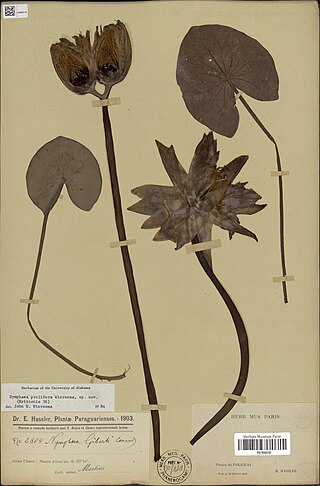Top Qs
Timeline
Chat
Perspective
Nymphaea prolifera
Species of water lily From Wikipedia, the free encyclopedia
Remove ads
Nymphaea prolifera is a species of waterlily naturally found from Mexico (specifically Veracruz and Tabasco) to Brazil and northeastern Argentina.[1] Additionally, it has been reported to occur in Uruguay.[2][3]
Remove ads
Description
Vegetative characteristics

Nymphaea prolifera is a perennial aquatic herb.[4]
Generative characteristics



The floral odour has been described as musty.[5]
Cytology
Nymphaea prolifera is aneuploid. The chromosome count is 2n = 18.[6][7]
Remove ads
Reproduction
Fruits and seeds are only produced on very rare occasions. Instead, the main form of reproduction relies on the sterile, tubiferous flowers as a form of vegetative reproduction.[4] Due to those vegetative propagules, it can persist through periods of decay.[8] The tubers readily separate and it is common to see numerous floating tubers in the water. They drift briefly in the water, until they establish roots to anchor themselves in the mud. When the water level declines, the tubers are likely embedded within the substrate.[9][10]
Remove ads
Taxonomy
Nymphaea prolifera was first described by John Harry Wiersema in 1984.[1] It is placed in the subgenus Nymphaea subg. Hydrocallis.[4]
Etymology
The specific epithet prolifera references its distinctive trait of proliferous asexual reproduction.[11]
Conservation
It is a rare species.[12]
Ecology
Summarize
Perspective
Pollination
The flowers are likely entomophilous (i.e. insect-pollinated).[12]
Habitat
In Mexico, Nymphaea prolifera was collected in temporarily flooded meadows at the roadside, at depths of 30 to 60 cm. The populations appear shortly after the onset of the rainy season.[10] Its habitat within the Pantanal consists of flooded clay fields.[13] It is also found in swamps, temporary ponds, pastures.[12]
Herbivory
This species experiences low levels of herbivory in the growth period. This may be explained by a high tannin content of 5.40%, as tannins are known to reduce insect herbivory.[8] Few occurrences of adult Hydrotimetes natans beetles, which are being used as a biological control agent of Cabomba caroliniana in Australia, have been observed on Nymphaea prolifera in its natural habitat. In a laboratory setting, it was shown that adult beetles can feed on Nymphaea prolifera leaves, although it prefers Cabomba caroliniana. The beetle larvae are host specific to Cabomba and fails to enter stems of Nymphaea prolifera.[14] The feeding behaviour of a different beetle species Neochetina eichhorniae was also evaluated. Despite the high nitrogen and low lignin contents of Nymphaea prolifera foliage, the beetle showed a low preference for Nymphaea prolifera as a food source and it is unlikely this beetle would feed on Nymphaea prolifera under natural conditions.[15] In its natural habitat, 13.3% of leaves had petioles damaged by endophagous larva.[16]
Nymphaea prolifera synthesises methylated benzenoids to repel waterlily aphids, which feed on the flowers.[17]
Remove ads
Cultivation
It is rarely cultivated.[18]
References
Wikiwand - on
Seamless Wikipedia browsing. On steroids.
Remove ads

